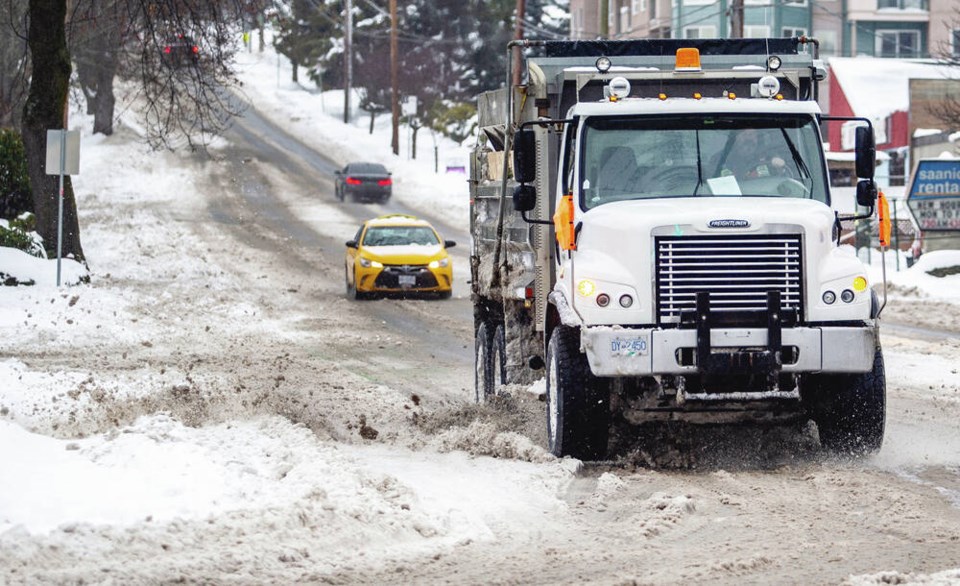Snow-removal budgets and equipment will likely be on many council agendas in 2023, as snow days become a more regular feature of winter on the Island.
“It has to be more routinely part of our planning,” said Victoria Mayor Marianne Alto, noting the city has experienced significant snowfall at least once during the winter for several years now.
“Despite the fact there’s an enormous number of people who live in Victoria because they want to avoid the rest of Canada’s winter, the reality is that it seems that we can’t avoid it entirely.”
Alto said snow removal and equipment will need to be regular budget items for Victoria and other cities in the region.
Victoria’s annual snow-removal budget was $430,000 for 2022, though the city could not say if it had exceeded that this year.
“The bottom line is the city will spend what is required to do the job,” said spokeswoman Colleen Mycroft.
The city currently has seven plows and a number of Bobcats and bucket trucks that are used to move snow from downtown — when it doesn’t melt quickly — to dumping areas at Topaz and Beacon Hill parks.
Alto said the city has plans that take into account the changing climate and whatever that brings, be it snowstorms, atmospheric rivers and extreme heat events.
If the budget is increased and the money isn’t used, it can always be reallocated or carried forward, she said.
“It’s now time for us to be realistic and understand that climate adaptation means us expecting and planning for weather which used to be unusual, but now isn’t,” she said.
Esquimalt Mayor Barb Desjardins said storms will continue to happen and the municipality needs to look at “how we create equality and accessibility through snow removal as quickly as possible,” she said. “That means looking at things like snow removers and specific sidewalk-cleaning equipment as well.”
She said the past few days have been an eye-opener on the effect a build-up of snow can have on some people’s ability to get to work, appointments and shopping, even when roads and sidewalks have been cleared.
She said when spaces at a bus shelter, for example, are blocked by a pile of snow, it can be an insurmountable obstacle for some, which could mean smaller dedicated equipment is needed.
She noted some Esquimalt retailers have snowblowers to ensure access for all.
“If small business people are seeing this, I think that we as municipalities certainly need to have a look at how much better can we do it,” she said.
In Saanich, Mayor Dean Murdoch said the municipality will be assessing its options for how to prepare to respond quickly to large accumulations of snowfall.
Snowfall events are clearly becoming more frequent, he said, which “goes hand in hand with those extreme heat events we’re going to have in the summer and the flooding events in the fall and spring.”
“This snowfall was a pretty significant accumulation in a very short amount of time, which is always going to be taxing in a community where we traditionally haven’t been equipped to respond quickly for a significant accumulation,” he said.
Saanich’s snow-removal budget was about $200,000 in 2021, and was increased for this year using a five-year average. The municipality has two graders, seven large plows and two smaller plows that have been working around the clock over the past week.
Saanich council approved two new front-plow trucks last budget to augment the fleet, but due to supply-chain issues they could not be delivered ahead of this winter season.
In Langford, director of engineering and public works Michelle Mahovlich said the debate about increasing services always arises when there is a big snowfall.
“If you increase your service and then no snow comes, you are paying for people and equipment with no result. Conversely, not increasing services but then receiving more snow or adverse weather than expected is also not ideal,” she said. “There is not one solution that will solve everyone’s expectations when it comes to snow clearing.”
Mahovlich said the district’s entire fleet of plows, brine trucks, sanders and salters was on the streets Friday, and the district was grateful for the many drivers who heeded warnings to stay home so roads could be cleared more easily.
Sidney Mayor Cliff McNeill-Smith said the town looks at its snow removal budget every year, bumping it up to $60,000 this year, but like other municipalities, it will spend what it must to get the job done.
He said Sidney’s snow removal equipment is multi-purpose and used for other tasks through the year, and they would have to carefully consider investing in dedicated snow removal equipment for the relatively few days it’s needed.
“It’s a valid point with regards to [the effects of] climate change, and right now it’s causing us to spend more on stormwater management because of that significant rain event in November 2021,” he said, adding town staff will offer a snow removal report during budget discussions in the new year.
“Sidney staff have hit all the priorities this year and still been able to plow some of the street parking for the downtown business district knowing it’s an important time of the year.”
>>> To comment on this article, write a letter to the editor: [email protected]



